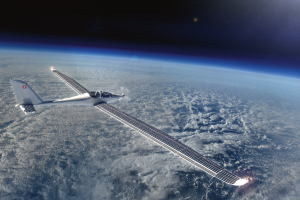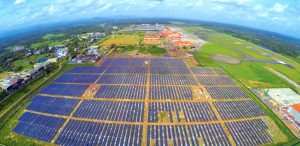



What do we associate photovoltaic modules with today? Does it offer enough reliability and redundancy to be used by such strictly regulated industries as Aviation. Or maybe it can only serve as source of free electricity for small businesses and households?
 Believe Or Not: First Usage of Solar Panels
Believe Or Not: First Usage of Solar PanelsFirst commercial usage of solar photovoltaic modules (further “PV”) took place in space industry. It was in 1950s and 60s when satellites in the USA’s and Soviet’s space program were powered by PV modules. At that time, solar panels were very expensive, so commercializing started only twenty years later when cost of cells has significantly decreased. In the 1980s PVs were used everywhere – on buildings, vehicles, and consumer equipment.
Space Agencies continue implementing solar technologies in their projects. While planning human mission on Mars in 2030s – NASA asked Massachusetts Institute of Technology (MIT) to find the most suitable option to generate power there. MIT study proved that PV power systems achieve comparable levels of performance as systems based on nuclear fission power.
Solar energy has proven its reliability in Space conditions. Now Aviation slowly implement solar power as primary source of energy
 Journey To Space Inside An Airplane
Journey To Space Inside An AirplaneSolarStratos is planning to offer passengers a five-hour flight to stratosphere in 2018 as part of plans to revolutionize solar flight travel. 100% solar powered craft will take two hours to ascend to space and spend 15 minutes “with the stars”.
In 2016 people have had a chance to observe the first in the history round-the-world trip powered by solar energy. The plane SolarImpulse carried out more than 17,000 solar cells on its wings, flew 40 000 km without fuel.
 More and more airports are convinced that solar power is the Future
More and more airports are convinced that solar power is the FutureToday 100 the most innovative airports are already using solar-power systems on a large scale. The reasons are very clear: lower capital expenditures and operational costs, very fast implementation, high safety and autonomy, independency from 3rd party suppliers, significantly less environmental impact.
It’s not surprising that the first 100% solar powered airport occurred in India. “We wanted to be independent of the electricity utility grid,” told Jose Thomas, the Cochin airport’s general manager. The big project cost around $9.3 million and is expected to be saved in less than six years by not having to pay for electricity anymore.

Solar Generator in Cochin Airport
Followed by Cochin, George Airport in South Africa became the second airport completely operated on solar panels. Since 2015 it has reduced its carbon dioxide emissions by 1,229 tones and hopes to achieve zero emissions by 2030.
Heathrow, San Diego international airport and Indianapolis, Karratha Airport in Australia and many others are examples of successful solar energy implementation.
Borrego Solar CEO Mike Hall said about project in San Diego: “This project will be a great complement to the energy reduction initiatives the airport has already undertaken and will show others in the region that the technology exists for large energy users to make a cost-effective switch to reliable on-site solar energy.”
“The Solar Farm not only enhances our environmentally friendly and energy-efficient terminal campus, but also played a huge role in our recent recognition of being named one of America’s greenest airports”, said Mario Rodriguez, executive director of the Indianapolis Airport Authority.
Solar panel installed on a roof can provide an entire house with enough electricity; solar farm near airport can provide with enough electricity not only its terminals and technical buildings, but even nearby houses and shops as well.
What about implementing solar power in airfield ground lighting, so that there is no need in paying for electricity bill and maintenance anymore?
Due to introduction of power-saving LED technology, increasing efficiency and decreasing cost of photovoltaic cells – solar-powered AGL (Hybrid AGL) is gradually becoming one of standards in airport infrastructure. First used as back-up systems today Hybrid AGL is used by more and more airports as primary airfield ground lighting so there is finally a reliable alternative for conventional lighting systems.
Within a couple of decades solar energy transformed from complex and quite expensive source of electricity used only in space and military applications to a global mass-produced alternative energy source. Today it is widely used in aviation.
About 100 large airports around the world are already experiencing advantages of solar energy. Domestic and regional airports, helipads, police and military service are frequent users of solar-powered lighting systems. In some cases it is a highly competitive alternative to cabling system, for others – the only available option to run night operations.
Hybrid AGL is not a new concept as used for almost 15 years. It is reliable solution and can be installed in few days. Airport’s forecasts and financial reports show cost efficiency and growth of profitability after installing H-AGL. The technology is tested and efficiency is proven .